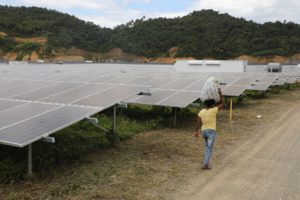NGCP exec: P52-B VisMin interconnection project on track

SOLAR POWER/FEB 28,2018: Resident allowed to enter the solar farm to sale their goods to the market. The 73 hectare Toledo Power Corp. operated by Citicore Power Inc. in Talavera, Toledo City. (CDN DRONE PHOTO/TONEE DESPOJO)
A P52-BILLION National Grid Corp. of the Philippines (NGCP) project to link power grid of Visayas and Mindanao is on track for its completion in 2020.
The different packages of the project called the Mindanao-Visayas Interconnection Project (MVIP) have already been awarded to or have been undergoing bidding.
Christian Ereno, NGCP Visayas System Planning head, said the project was on track for its target completion in December 2020.
“I’d like to stress that this project is not only beneficial to the Visayas grid but all over the country; not only to generators but also to load consumers,” Ereno said during the Visayas Energy Investment Forum earlier this month.
Once completed, the Mindanao grid will become connected with the Visayas grid which is already connected to the Luzon grid; thereby making the country a one whole power grid.
The MVIP consists of a 92-kilometer submarine cable between Dapitan, Zamboanga del Norte and Santander in Cebu where the terminal station will be located.
Ereno said that they had already awarded the contracts for the converter stations.
He, however, said that the transmission lines had to be divided in several packages since the project would involve long transmission lines, some had already been awarded.
The DC and AC lines in Mindanao are also awarded already while other portions are still in the bidding process.
As for the submarine cable component, Ereno said it was the first to be awarded to a contractor earlier this year.
Renewable energy
According to Ereno, connecting the Mindanao grid to the already connected Luzon-Visayas grid would help patch up the increasing power demand in the Visayas region especially in Cebu, by tapping the energy generation surplus in Mindanao.
He said that this would also help stabilize the power supply in the Visayas area which had a lot of renewable energy sources like solar and wind power.
“Solar farms and wind farms, these are variable renewable energy plants. Their output fluctuates. So we need other power plants to regulate their outputs,” he said.
Ereno said that the Visayas region had been lucky to be connected with the Luzon grid because problems on power shortage could be addressed by tapping the surplus power in Luzon.
However, the Department of Energy (DOE) has been citing the growing demand in the Visayas, especially in Cebu, fueled by more economic activities.
DOE Assistant Secretary Redentor Delola earlier called on the private sector in the Visayas to invest in more projects in the power sector.
Delola said that no problems had been foreseen with regard to the Visayas supply in the next three years or so but something had to be done as early as now.
Traditional power plants like coal-fired power plants would usually take a longer time of three to five years to be established, but renewable energy plants like solar and wind could be set up in as fast as six months.
“Mindanao has a surplus of (power) generation and those generation can support the sudden decrease in output of solar plants when there is cloud cover,” NGCP’s Ereno said.
Disclaimer: The comments uploaded on this site do not necessarily represent or reflect the views of management and owner of Cebudailynews. We reserve the right to exclude comments that we deem to be inconsistent with our editorial standards.
